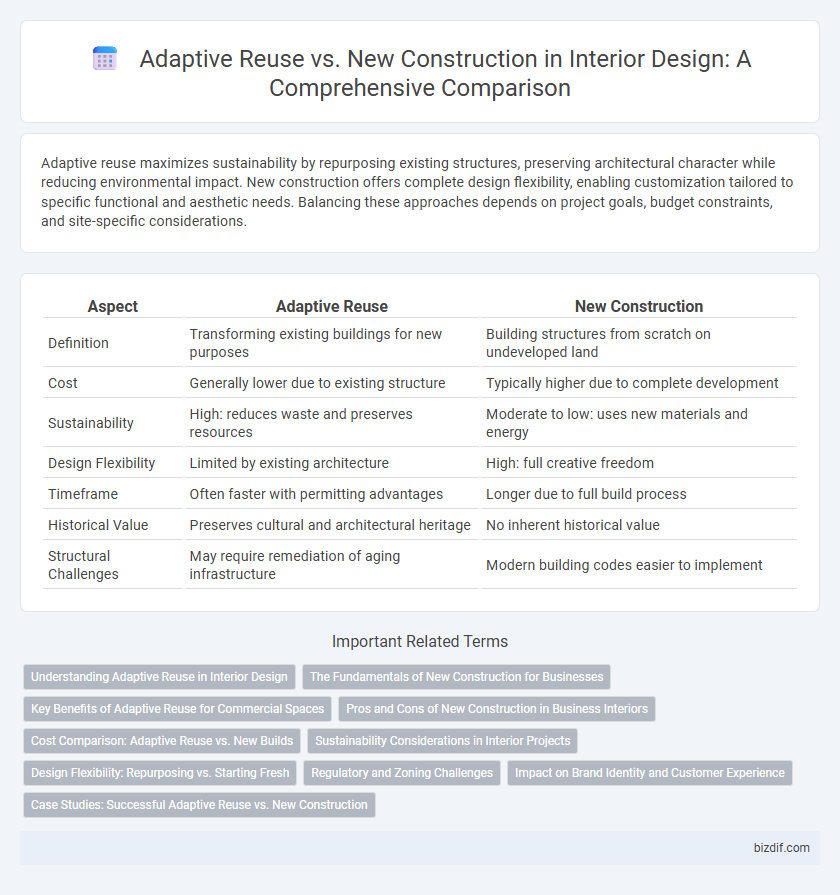Adaptive reuse maximizes sustainability by repurposing existing structures, preserving architectural character while reducing environmental impact. New construction offers complete design flexibility, enabling customization tailored to specific functional and aesthetic needs. Balancing these approaches depends on project goals, budget constraints, and site-specific considerations.
Table of Comparison
| Aspect | Adaptive Reuse | New Construction |
|---|---|---|
| Definition | Transforming existing buildings for new purposes | Building structures from scratch on undeveloped land |
| Cost | Generally lower due to existing structure | Typically higher due to complete development |
| Sustainability | High: reduces waste and preserves resources | Moderate to low: uses new materials and energy |
| Design Flexibility | Limited by existing architecture | High: full creative freedom |
| Timeframe | Often faster with permitting advantages | Longer due to full build process |
| Historical Value | Preserves cultural and architectural heritage | No inherent historical value |
| Structural Challenges | May require remediation of aging infrastructure | Modern building codes easier to implement |
Understanding Adaptive Reuse in Interior Design
Adaptive reuse in interior design involves repurposing existing buildings to create functional, aesthetically pleasing spaces while preserving historical and architectural elements. This approach reduces environmental impact by minimizing material waste and leveraging the embodied energy of existing structures. Emphasizing sustainability and unique design character, adaptive reuse offers innovative solutions compared to traditional new construction projects.
The Fundamentals of New Construction for Businesses
New construction for businesses involves creating purpose-built structures tailored to specific operational needs, ensuring compliance with current building codes, energy efficiency standards, and technological integration. It allows for complete control over spatial layout, materials, and sustainability features, optimizing functionality and brand identity from the ground up. Investing in new construction supports long-term scalability and minimizes unforeseen limitations often encountered in adaptive reuse projects.
Key Benefits of Adaptive Reuse for Commercial Spaces
Adaptive reuse in commercial spaces maximizes sustainability by repurposing existing structures, significantly reducing construction waste and material costs. It preserves architectural character and unique design elements, enhancing brand identity and customer appeal. Furthermore, adaptive reuse often allows faster project completion compared to new construction, accelerating business operations and return on investment.
Pros and Cons of New Construction in Business Interiors
New construction in business interiors offers complete design flexibility, allowing tailored layouts that optimize workflow and brand identity. However, it typically involves higher costs and longer timelines due to permitting, material sourcing, and build phases. The lack of existing structure constraints enables modern systems integration but may not capitalize on the sustainability benefits inherent in adaptive reuse projects.
Cost Comparison: Adaptive Reuse vs. New Builds
Adaptive reuse often presents significant cost savings compared to new construction by utilizing existing structures, which reduces expenses related to demolition, foundational work, and permits. New builds typically incur higher costs due to extensive site preparation, material procurement, and labor for constructing from the ground up. Lifecycle costs also favor adaptive reuse, as repurposed buildings can qualify for tax incentives and sustainable certifications, lowering long-term operational expenses.
Sustainability Considerations in Interior Projects
Adaptive reuse in interior design significantly reduces environmental impact by minimizing demolition waste and conserving existing materials, supporting sustainability goals more effectively than new construction. New construction typically requires higher energy consumption and resource extraction, contributing to a larger carbon footprint compared to repurposing existing structures. Prioritizing adaptive reuse enhances energy efficiency, reduces landfill contributions, and promotes circular economy principles in sustainable interior projects.
Design Flexibility: Repurposing vs. Starting Fresh
Adaptive reuse offers superior design flexibility by repurposing existing structures, allowing designers to creatively integrate original architectural elements with modern functionality. New construction provides complete freedom to tailor layouts, materials, and systems from the ground up but often requires greater resource investment and time. Choosing between these approaches depends on project goals, sustainability priorities, and the desired balance between preserving character and enabling innovative design solutions.
Regulatory and Zoning Challenges
Adaptive reuse projects frequently encounter complex regulatory and zoning challenges due to codes originally designed for new construction, necessitating extensive negotiations with local authorities to allow mixed-use spaces or historical preservation exceptions. New construction benefits from clearer zoning classifications and modern code compliance, but often faces stricter environmental regulations and longer permitting timelines. Interior designers must collaborate closely with architects and planners to navigate these constraints, ensuring functional, compliant, and aesthetically cohesive outcomes.
Impact on Brand Identity and Customer Experience
Adaptive reuse strengthens brand identity by preserving historical elements that resonate with customers, creating a unique and authentic environment. New construction offers complete design freedom, allowing brands to tailor spaces precisely to their vision but may lack the established character that fosters customer loyalty. Both approaches significantly influence customer experience through spatial storytelling and ambiance, but adaptive reuse often provides a more memorable and emotionally engaging setting.
Case Studies: Successful Adaptive Reuse vs. New Construction
Case studies highlight that adaptive reuse projects often achieve sustainability goals more effectively than new construction by preserving existing structures and reducing material waste. Successful examples, such as the Tate Modern in London and the High Line in New York City, demonstrate how transformed buildings can maintain cultural heritage while meeting modern design standards. In contrast, new construction projects like the Burj Khalifa showcase innovative design possibilities but typically require higher resource investments and environmental impact.
Adaptive reuse vs New construction Infographic

 bizdif.com
bizdif.com